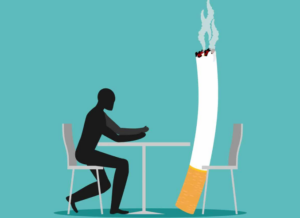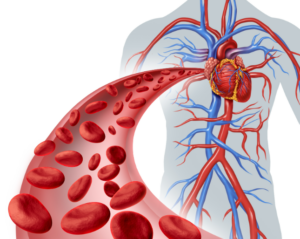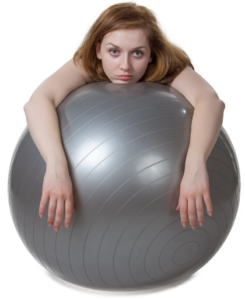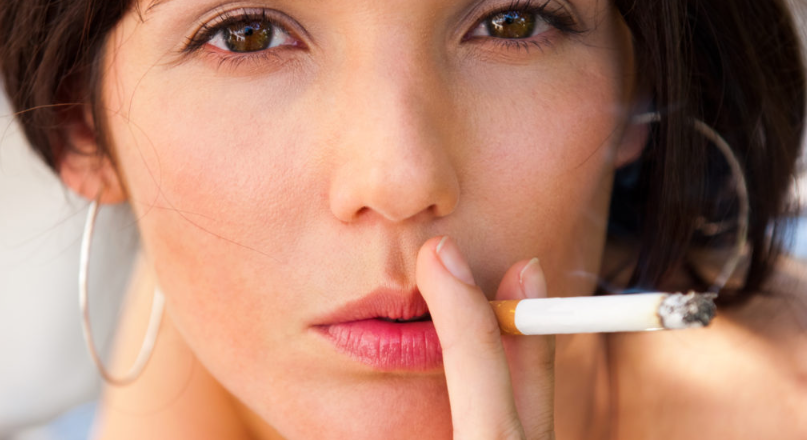You’re not dead yet.
But it could come sooner than you think—even with an excellent diet.
If you sit on your ass all day at any kind of desk or cubicle job like most modern-day adults, you’re already in trouble.
You’re probably wondering:
What does this have to do with smoking?
It is one of the habits known to end your life prematurely with a number of unforgiving cancers. People who care about their health don’t do it.
Period.
But is smoking as bad as you think?
If you think smoking is worse for you than sitting all day, smoking isn’t as bad as you think it is.

Don’t get me wrong; smoking is terrible.
Sitting all day is also terrible.
And there’s lots of proof:
In 2014, the Journal of the National Cancer Institute published a large review that confirms the awful truth.
It analyzed data from over 4 million participants regarding their sitting habits and rates of cancer.
The results were shocking:
Are you sitting down?
Because you may want to stand…
Prolonged sitting was linked to a 24% increased risk of colon cancer, a 32% increased risk of endometrial cancer, and a 21% increased risk of lung cancer. WTF?!
“Sitting is more dangerous than smoking, kills more people than HIV and is more treacherous than parachuting. We are sitting ourselves to death.”
Mayo Clinic
Well, that’s a buzzkill.
Levine is not alone in his findings. Other researchers point to evidence that suggests prolonged sitting not only increases our risk for developing a variety of cancers but also for diabetes and heart disease.
Another study published in the American Journal of Epidemiology found that individuals who sat more than 6 hours a day died earlier than people who only sat for about 3 hours a day (mostly from cardiovascular disease).
And research published in the Journal Diabetologia found that for every hour spent sitting, people increased their risk of developing type-2 diabetes by 3.4%.
Every hour.
This percentage rose up to 30% when people spent an entire day sitting.
What Exactly Are We Doing on Our Asses All Day?
Forget hunting and gathering or even paleo.
It wasn’t that long ago that our ancestors spent the day working in fields, tending to crops and livestock, and generally staying busy with the physical tasks that kept them clothed, fed, and alive.
Life didn’t involve hours spent staring motionless at a screen.
Over the years, we developed a habit of sitting every chance we get. Please, have a seat; sit down and take a load off; and sit and relax are said with good intentions.
The average office worker sits for about 8 hours each day, on a computer, making calls, eating lunch, and answering emails.
Of course, before this employee can even sit for that long they first have to sit in their car.
The average commute is anywhere from 20 minutes to an hour to get to work, and then they’ll sit that long to get back home.
Once home, what do most people do?
Sit down with family for dinner, then get up, and move to the sofa for two to four hours binge-watching really bad television.
And the next day we do it all over again.
Unless, of course, we mix it up with a few hours of online shopping and social media.
Why Does Inactivity Make Us Sick?

Sitting wreaks havoc on our bodies and health in a couple of different ways:
When we sit more than we move, our body shuts down as muscles go into a state of inactivity. It’s part of why you feel so tired after sitting for an extended period. When leg muscles are inactive, circulation through the entire body decreases. This means less oxygen-rich blood flow to the organs and cells that need it to fight disease.
You also use less of your blood sugar and you burn less fat, which further increases your risk of heart disease and diabetes.
Inactivity also suppresses a gene that helps with inflammation, blood clotting, and overall heart health. In short, being sedentary tells the body we’re ready to shut everything down.
All is Not Lost
Though much of the research is no longer new, even fitness experts have a hard time accepting the dire outcomes of not moving.
It’s easy to understand how smoking damages our cells.
It’s black smoke, full of chemicals and carcinogens, inhaled deeply into our precious lungs.
Of course, it will kill you.
But death by screen time?
 The evolution of technology has far outpaced the needs of our bodies.
The evolution of technology has far outpaced the needs of our bodies.
We still need to move.
A lot.
We were engineered to survive through movement.
It was a perfect pairing when our survival required constant activity and our health benefited as we worked.
Now that we’re missing half the equation, we’re getting sick.
It doesn’t help that our lifestyles make even light exercise almost unnatural.
Most people could get through 99% of their week without elevating their heart rate.
I know I could.
It doesn’t take wildly ambitious fitness goals to gain significant health benefits.
You can make improvements in your health and increase your life expectancy with just a moderate amount of exercise.
And it’s not an all-or-nothing arrangement:
The impact of exercise on health is dose-dependent.
So, even a little exercise makes a notable improvement, and the more you do the better your health gets.
Did You Know?
A mere 21 minutes a day of exercise can extend your life by several years?!
Why don’t we all just exercise more?
You know the reasons and they’re good.
How do I know this?
Because we all have the same basic aversions to working out.
Let me take a few guesses:
 Working out sucks.
Working out sucks.
The message we get about exercising is that we need to be hitting the pavement hard several times a week to be healthy. No pain, no gain. Not surprisingly, this message is wrong. In fact, many studies on runners show that too much vigorous exercise reverses the benefits of doing it at all. When you think about our ancestors or animals in nature, they don’t go running at full speed for an hour—unless they’re being chased. There is a better way.
You hate going to the gym.
We all do. Gym memberships are expensive and despite all their efforts, gyms have been unable to create a welcoming environment where we feel comfortable and at home. When I arrive at a gym, my whole focus is getting done and getting out of there. Taking care of yourself shouldn’t feel this way.
There’s no time for exercise.
You’re not alone. It’s easy to make time for exercise once or twice. It can be nearly impossible to make it happen on an ongoing basis. There’s just too much to focus on in a single day and because exercise isn’t an urgent task, it falls to the bottom of the priority list and never happens. If you could just stop everything you’re doing and quickly work out on the spot for 20 minutes, it might work. But just the round trip travel time to the gym can be close to an hour. And that doesn’t include the workout.
The weather makes outdoor exercise unappealing.
Whether it’s 95 degrees and humid or pouring down rain and chilly, the climate can make it easy to say no to exercise. Who wants to be miserable? Not to mention how dark it gets in the winter. As I type this article, at 4:45 in the afternoon, it’s already dark out. It’s not exactly inspiring me to head outside for a workout. In fact, quite the opposite.
There’s an Easier Way
You don’t need to buy expensive equipment or join a dreaded gym. Most people don’t have room in their homes for such equipment anyway and the willpower required to drag yourself to a gym for the rest of your life isn’t realistic.
equipment anyway and the willpower required to drag yourself to a gym for the rest of your life isn’t realistic.
Regular exercise is easy to do when you avoid the usual methods.
If you want to exercise but can’t figure out how to make it work for you, read the next section for a better solution.

